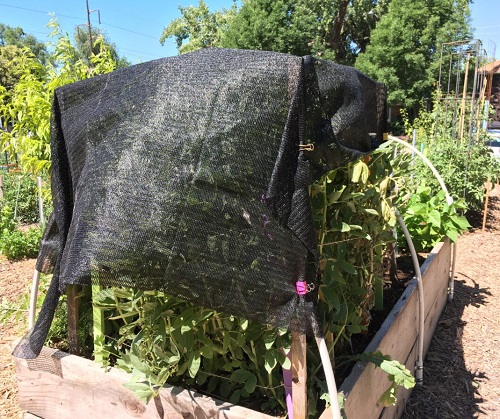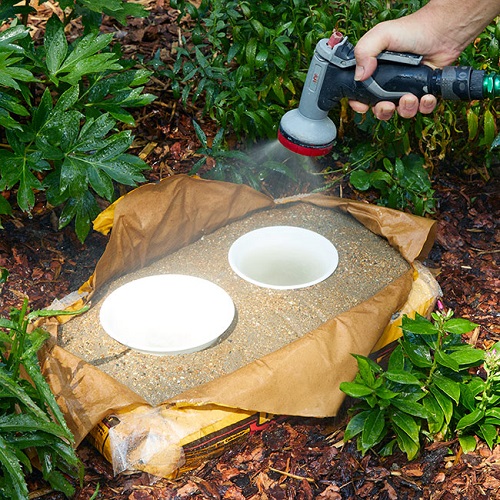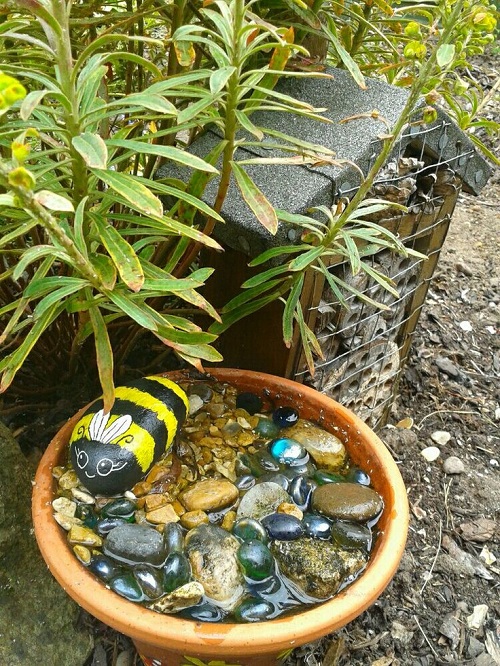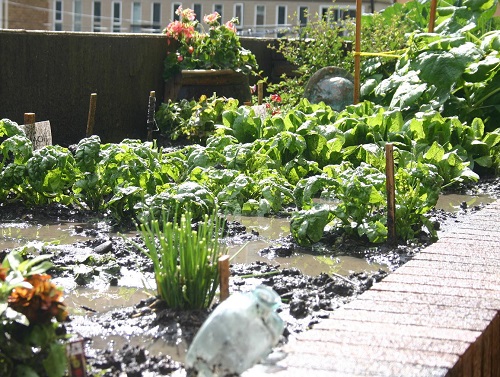Here are the top Master Gardener’s Tricks to Improve Beneficial Insects in Garden for a thriving ecosystem.

Check out these Master Gardener’s Tricks to Improve Beneficial Insects in Garden! Discover proven techniques from seasoned gardeners to create a thriving ecosystem that supports beneficial insects and promotes a healthy, vibrant garden.
Here are 8 Secret Master Gardener’s Tips to Get the Most Colorful and Vibrant Flowers
Master Gardener’s Tricks to Improve Beneficial Insects in Garden
1. Go for Diverse Plant Varieties
The first step to improving beneficial insects is to provide them with an assortment of plants to feed on and find shelter. Aim for a diverse selection of flowering plants that bloom at different times throughout the year.
This diversity will not only enhance the visual appeal of your garden but also improve beneficial insects in garden, including bees, butterflies, and ladybugs.
What Attracts Beneficial Insects
- Bees: Bees are crucial pollinators that play a vital role in plant reproduction. Planting nectar-rich flowers like sunflowers, zinnias, and cosmos will attract bees.
- Butterflies: Similar to bees, they are attracted to nectar-rich flowers. Planting flowers like lavender, salvia, and coneflowers will entice butterflies to visit your garden, contributing to pollination efforts. You can also go with butterfly bush, milkweed, and lantana.
- Ladybugs: Ladybugs are beneficial insects that prey on aphids, mites, and other small pests. Planting dill, fennel, and parsley will attract ladybugs as these plants provide shelter and a source of food in the form of aphids and other pests.
- Lacewings: Similar to ladybugs, lacewings are attracted to dill, fennel, and parsley due to the presence of aphids and other prey species. They are also attracted to yarrow, coreopsis, and marigolds.
- Hoverflies: Hoverflies are attracted to flowers like lavender, asters, daisies, and phlox. These plants lure hoverflies to your garden, providing them with a food source while also benefiting from their pest control activities.
Here are the Most Beneficial Garden Insects You Should Avoid Killing
2. Say No to Pesticides
Excessive pesticide use can have detrimental effects on beneficial insects. Chemical insecticides not only kill harmful pests but also harm beneficial insects in the process.
Whenever possible, opt for organic pest control methods, such as neem oil or insecticidal soaps, which are less harmful to beneficial insects. Here are some key points to consider.
- Instead of relying solely on chemical insecticides, explore organic pest control methods that are safer for beneficial insects.
- Implement an IPM (Integrated Pest Management) approach to manage pests while minimizing the impact on beneficial insects. IPM combines multiple strategies to control pests, including cultural, physical, and biological methods.
- Practice tolerance and accept a certain level of pest presence and understand that beneficial insects play a crucial role in maintaining a balanced ecosystem. Not all insects in your garden are harmful.
- Keep a close eye on your garden to detect early signs of pest outbreaks. Regular monitoring allows you to intervene promptly and take targeted actions without causing harm to beneficial insects.
This Amazing Natural Pesticide Recipe Is So Effective You Can Get Rid Of Pests In No Time
3. Pay Attention to the Night
While many beneficial insects are active during the day, some are nocturnal and play a crucial role in pollination and pest control.
To attract these nighttime beneficial insects, incorporate plants that release strong fragrances in the evening. These fragrances act as signals, guiding the nocturnal insects toward the blooms and helping them locate food sources.
Plants to Attract Beneficial Insects at Night
- Moonflowers (Ipomoea alba): Moonflowers are large, white, and highly fragrant flowers that bloom at night. Their intoxicating scent attracts a variety of nocturnal pollinators, including moths and certain species of bats.
- Evening Primrose (Oenothera): The evening primrose is known for its vibrant yellow flowers that open in the evening. These flowers release a sweet fragrance that entices nighttime pollinators, such as hawkmoths and certain species of bees.
- Flowering Tobacco (Nicotiana tabacum): Nicotiana, commonly known as flowering tobacco, produces tubular, trumpet-shaped flowers that open in the evening. The moths are particularly drawn to the high sugar content of the nectar and play a vital role in the pollination of these plants.
- Jimsonweed (Datura stramonium): The flowers of Datura emit a powerful, intoxicating scent that attracts hawkmoths. These pollinators are attracted to the copious amounts of nectar produced by the plant.
- Four O’Clocks (Mirabilis jalapa): Four O’Clocks are named after their intriguing characteristic of opening their fragrant flowers in the late afternoon or early evening. Their sweet scent attracts hawkmoths and sphinx moths during the night and butterflies, bumblebees, ladybugs, and hummingbirds during the day.
Here are 17 Night Blooming Fragrant Flowers with Strong Scent
4. Set up Overwintering Sites

Many beneficial insects overwinter in the garden, seeking shelter and protection from the cold. By providing suitable overwintering sites, you can ensure a healthy population of beneficial insects in the following seasons. Here are effective overwintering sites you can go with.
How to Set Up Overwintering Site for Beneficial Insects
- Leave Plant Stems and Dead Vegetation
- As winter approaches, refrain from cutting back all the plant stems and dead vegetation in your garden.
- Instead, leave a portion of the stems and vegetation standing throughout the winter.
2. Sheltered Areas
- Look for areas in your garden that offer natural protection, such as the bases of shrubs or dense vegetation.
- These sheltered areas help create microclimates that are less exposed to harsh winds and extreme temperatures.
3. Create Habitat Features
- Incorporate elements in your garden that provide additional overwintering opportunities for beneficial insects.
- Install bug boxes or insect hotels, which offer shelter and nesting sites for a variety of beneficial insects.
4. Leave Bare Soil Undisturbed
- Many ground-nesting bees and other beneficial insects require bare soil for nesting.
- Designate a patch of bare soil in your garden and avoid disturbing it throughout the winter.
You can also look for DIY videos to help you out. Here is one to get you started.
Here are 9 Masterful Tips for Overwintering Balcony Garden Plants
5. Provide a Water Source
Offering a water source in your garden is essential for improving beneficial insects in garden. Shallow dishes filled with clean water or small birdbaths can provide drinking spots for bees, butterflies, and other beneficial insects.
Larger water sources such as ponds or pools attract larger insects such as dragonflies that prey on beneficial insects; instead, go with the following DIY Insect Water Source for your garden.
What you will need
- Shallow bowl or dish
- Pebbles
- Small sticks
- Natural items (Shells or pine cones)
Steps
- Choose a suitable vessel for water. Use a plant saucer or any shallow dish. Size doesn’t matter, but remember that a shallow dish needs more frequent water top-ups.
- Place pebbles in the dish for insects to access the water safely. You can add shells or pine cones, but avoid smooth items like marbles.
- Add small sticks on top of the pebbles. They will float when the water level rises, ensuring insects always have a place to drink.
- Fill the dish with water, leaving the pebbles exposed. Periodically empty and refill the station to keep the water clean and fresh.
- Place the watering station in a cool, partly shady spot near flower beds or pots with high insect activity. Position it where you see insects frequently, like scarlet tiger moths visiting a favorite spot in your garden.
If you get stuck in any of the steps, you can check out this detailed DIY.
Learn the tips and tricks of how to water your plants when you are away here
6. Plant Native Species

Native plants are a valuable addition to any garden, not only for their aesthetic appeal but also for their significant benefits to native insect populations. These plants have evolved alongside local beneficial insects over centuries, creating intricate ecological relationships.
Incorporating native species into your garden design provides a familiar and reliable food source, nesting sites, and habitat for beneficial insects, which in turn contributes to a thriving and sustainable garden ecosystem.
Researching native plant species in your specific region is crucial to selecting the most appropriate plants for your garden. Consider factors such as climate, soil conditions, and available sunlight to identify native plants that will thrive in your area.
Local botanical gardens, native plant societies, and extension offices can provide valuable resources and information on native plant species suitable for your region.
Native Planting Tip: When incorporating native plants into your garden, aim for a variety of species that bloom at different times throughout the growing season. This ensures a continuous food source for beneficial insects.
Here are 8 Secret Master Gardener’s Tips to Get the Most Colorful and Vibrant Flowers
7. Create a Muddy Patch
A muddy patch in your garden can serve as a valuable resource for specific beneficial insects, especially solitary bees and wasps. These insects require moist soil to construct their nests and rear their offspring.
Solitary bees, including mason bees and leafcutter bees, are excellent pollinators and play a crucial role in flower and fruit production. By creating a muddy patch, you offer these bees an ideal location to construct their nests and lay their eggs.
Here are steps to help you establish a successful muddy patch and improve beneficial insects in garden.
How to Create a Muddy Patch for Insects
- Choose the Location: Select an area in your garden that receives partial shade to prevent the soil from drying out too quickly. Ideally, the location should have well-draining soil.
- Dig a Shallow Depression: Dig a small depression in the soil, approximately 6-12 inches in diameter and 4-6 inches deep. The size can vary depending on the space available and the number of beneficial insects you wish to attract.
- Keep the Soil Moist: Regularly water the depression to keep the soil consistently moist. Avoid overwatering, as this may cause the soil to become waterlogged, which can be detrimental to the nesting success of the insects.
- Compact the Soil: Gently tamp down the soil in the depression to create a compacted surface. This helps to maintain the moisture level and provides a stable foundation for the insects to construct their nests.
- Provide Nearby Nesting Materials: Place natural nesting materials nearby, such as bundles of hollow stems or drilled wooden blocks. These materials offer additional nesting opportunities for solitary bees and wasps.
Invite these 10 Pollinators to Have the Most Productive Garden
8. Make a Butterfly Puddling Station

Butterflies are not only a delight to observe but also serve as important pollinators in your garden. Creating a butterfly puddling station can attract these beautiful creatures and provide them with the essential minerals they need for reproduction and survival.
A butterfly puddling station is a simple yet effective addition to your garden. Here is how you can create one.
Materials
- Bag of premixed concrete (e.g., QUIKRETE Sand/Topping ready-to-use mix)
- Packing tape
- Box cutter
- Latex gloves
- Hose spray nozzle with mister settings
- Two bowls of desired size (For the puddler)
Steps
- Set a bag of dry, premixed concrete in the garden, and tape the edges with packing tape to help it hold its shape.
- Use a box cutter to cut an “X” through the paper of the bag from corner to corner and peel back the paper to create an open rectangle.
- Press indentations into the exposed dry concrete using two bowls of different sizes, one for shaping the puddler and the other for holding fruit.
- Keep the bowls in position and mist the concrete evenly with water using the mister setting on a hose nozzle.
- Allow the concrete to cure for four days, then peel off the dried paper bag.
- Pour a mud mix of half sand and half compost or manure into one indentation, and dampen it for butterflies to obtain moisture and minerals. Place overripe fruit in the other bowl as a food source for butterflies.
You should ensure the puddler remains moist and provide fresh food sources as needed to attract butterflies. Here is the thorough DIY for the Butterfly Puddler.
Here is How to Make a Butterfly Container Garden
9. Use Colors that Attract Bees and Other Beneficial Insects
Color plays a crucial role in attracting bees and other beneficial insects to your garden. By strategically adding plants with specific colors, you can create an environment that entices these helpful creatures.
Here are the colors that attract insects to the garden.
- Bees: Bees are attracted to blue, purple, and yellow flowers. These colors appear more visible to their compound eyes, making it easier for bees to locate and collect nectar and pollen.
- Butterflies: Butterflies are attracted to a variety of bright and vibrant colors, including red, orange, pink, purple, and yellow. These colors signal the presence of nectar-rich flowers and help butterflies locate food sources for feeding.
- Ladybugs: Ladybugs are attracted to flowers that have a bright yellow or white color, as these colors stand out to them and signal the presence of aphids and other small insects that they feed on.
- Lacewings: Lacewings are attracted to flowers with light colors such as white, yellow, and pale green. These colors reflect more ultraviolet light, which lacewings can see and are drawn to.
- Hoverflies: Hoverflies are attracted to flowers with bright yellow and white colors. These colors mimic the appearance of their favorite food for pollination and feeding.







